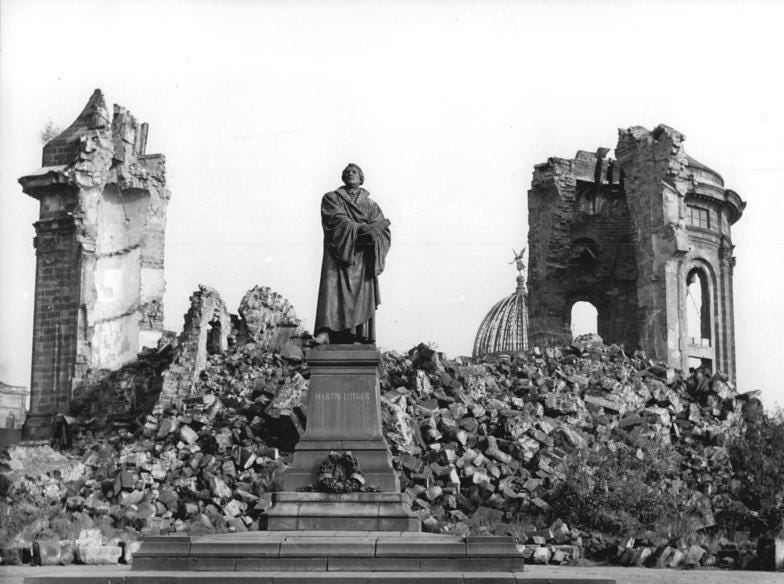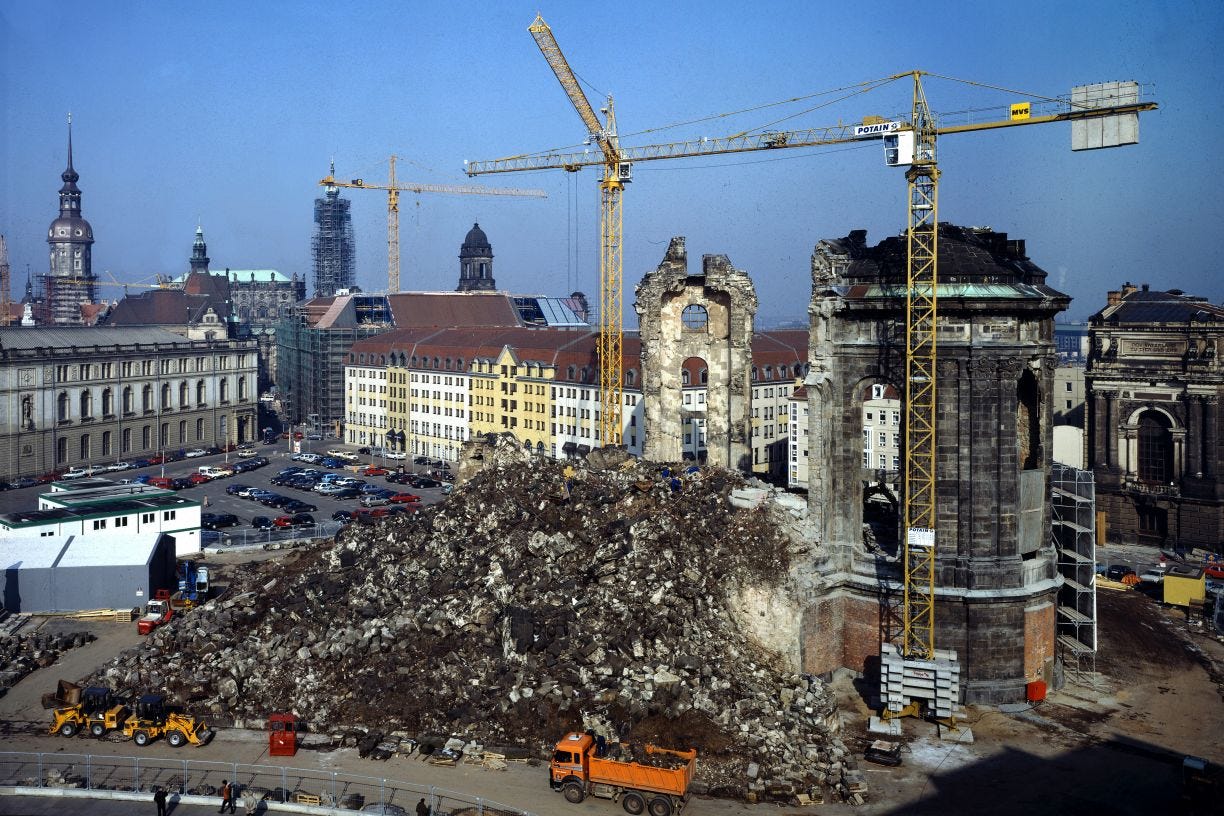ND Food & Travel Posts
RSS FeedRebuilding Dresden's Frauenkirche
I'm in the middle of writing a post about visiting and reflecting on Dresden, when I got pulled into a mini research project.
The landmark Frauenkirche was destroyed by UK and US bombers in February 1945, and left in ruins. It was respected as an anti-war monument. A photo from 1958 shows the ruins behind the statue of Martin Luther.

Bild Bundesarchiv / Giso Löwe / via Wikimedia CC-BY-SA 3.0
Shortly after the reunification of Germany, local organizers raised funds and began clearing the site.
A rebuilt Frauenkirche would reopen in 2005.

The main photo I've found of clearing debris, likely taken in 1993
From a cursory look of the timeline, the politics and austerity of East Germany likely played a role in the decision not to rebuild. But the connection is under-explored:
The reunification of Germany, brought new life to the reconstruction plans. In 1989, a 14-member group of enthusiasts headed by Ludwig Güttler, a noted Dresden musician, formed a Citizens' Initiative. [Wikipedia]
Finally, after the Berlin wall came down in 1989, the citizens of Dresden started intense discussions on the reconstruction of the Frauenkirche. Around 1990, the first plans for redeveloping the church started to appear under the name "Call for Dresden" [Sacred Architecture]
I decided to search for examples of support for rebuilding during the communist period, or opposition in the 1990s. This started me on a journey through Christian newspaper archives and art conservation publications.
Under East Germany
The church's website includes a few insights into the post-war period:
The wish to rebuild the Frauenkirche existed since the day of its collapse.
1982–1989: Every February 13th, an independent peace movement protested at the ruins with candles against the militarization of the GDR.
Independent Catholic News posted a traveler's memories of visiting in December 1988:
As we walked toward the centre of Dresden, jagged shapes loomed out of the mist. It had been forty-three years since World War Two, but still the ruins of buildings jutted up from the scorched earth of bomb sites. All that remained of the Residence and the Frauenkirche were charred window frames, crumbling walls, and heaps of stone.
[...]
However, the following morning, we discovered that the Communist authorities could do an excellent job of rebuilding war-damaged buildings, when they put their minds to it. The eighteenth century Zwinger Royal Palace and the Hofkirche were impressively pompous and Baroque; the Semper Opera was outrageously encrusted with wedding cake decorations inside and out; the Bruhl Terrace by the river, and street upon street of merchants' houses, had been beautifully reconstructed from the rubble of 1945.
The Semper Opera had reopened only a few years earlier; Frauenkirche may have been seen as "next in line" in a rebuilding process with resources to focus on only one place at a time. Other sources claim that the Dresden Castle would be next, and that restoration takes time. Some sections of Dresden Castle re-opened in 2005 and 2019.
One site claimed that the Frauenkirche was left due to the communists' anti-religious views.
Only a month after the Berlin Wall had been torn down, West German Chancellor Hermut Kohl visited Dresden and noted it as a place where people assembled during this transition period. He did not comment on rebuilding, even when recounting the story in 2005.
I had not actually planned to give a speech, but at that moment it was clear to me that I had to talk to the people. Wolfgang Berghofer, Dresden's mayor at the time, suggested that I speak in front of the ruins of the Frauenkirche.
[...]
I had the impression that the people assembled in front of the Frauenkirche were already looking toward a unified Germany. It was this prospect that filled them with enthusiasm, not so much the results of my negotiations.
The original declaration
The church's website includes a press release from the rebuilding campaign in 1990:
For decades, this ruin was an indictment and memorial for all peace-loving people. In the difficult times of political oppression and worldwide armament, young people repeatedly placed burning candles on the ruins. In non-violent protest they wanted to set signs of hope for a time of peace, justice and the preservation of life. But the further decay of the ruin cannot be stopped.
[…]
We also know that, in view of the decay of many buildings, new buildings and the preservation of old buildings are more necessary than the construction of the Frauenkirche.
Nevertheless, we do not want to resign ourselves to the fact that this unique and magnificent building should remain in ruins or even be demolished. We call for a worldwide campaign to rebuild the Dresden Frauenkirche into a Christian world peace center in the new Europe
Their Rebuilding Chronicle adds context to the "further decay" issue:
Scaffolding erected during GDR times to secure the northwest corner tower was used to map the exterior facade
After reunification
A 2019 Los Angeles Times article on Paris rebuilding Notre Dame claimed:
[the Frauenkirche was] a sort of ghoulish antiwar monument that even after the fall of the Berlin Wall, some 90% of locals thought should remain a memory
When I tried to trace this, I found a different stat in a 1994 article from the Christian Science Monitor.
[…] with the region struggling to recover from a depression, they are loath to divert precious tax funds to complete the project. A recent poll showed 85 percent of the population is against using tax revenue to fund the Frauenkirche reconstruction.
Not the same thing! The project had support from a lottery, international donations, musicians, and $1 million from Günter Blobel's Nobel Prize in Medicine.
Architecture professor Philipp Oswalt describes several German reconstruction projects as generally failing to get support at the ballot box or in public discourse ("participation was more simulatory than real"), with the Frauenkirche as the exception.
A 1991 article from The Art Newspaper agreed that public funds were needed for East Germany's housing crisis. It also shares outspoken opposition, from the architecture critic at Hamburg's Die Zeit.
Manfred Sack denounces the idea of a reconstruction as "madness" and sees the risk of a creating a historical lie. His main argument is that the ruin is a most valuable historical document, more valuable and honest than a copy of the lost unique original could be. Respect for history demands avoiding reconstruction at any price, and coming to terms with ruins which can be - and in the case of the Frauenkirche, are - often more moving and more instructive
By 1993, the same newspaper reserved less ink for critics:
Some Germans still feel that the ruins should be left as a memorial and others believe that the money would be better spent on housing or hospitals, but since reunification there has been growing enthusiasm to see the Frauenkirche rise from the ruins.
If someone does more academic research, it seems like these academic book chapters have more information, but I don't have access:
Conclusions
East Germany's struggling finances and suppressed political discussion made rebuilding the Frauenkirche seemed impossible. Peace rallies in the 1980s allowed young and pro-democracy Germans to adopt the future of the Frauenkirche for themselves. Reopening the East caused several changes to the economy, employment, access to foreign aid -which suddenly changed things. There was public debate about rebuilding, but it continues to serve as a symbol for peace.